Mooshimeter
The Mooshimeter is a multi-channel circuit testing multimeter that uses your smartphone or tablet, through Bluetooth 4.0, as a wireless, high-resolution graphical display. Each Mooshimeter is able to safely measure 600V at 10A with 24bit resolution from up to 150 feet away. If you're curious about the Mooshimeter's battery life, never fear, the meter uses two simple AA batteries and is capable of logging results for up to 6 months.
Next time you need to check the current on your robot's motors, connect the Mooshimeter and drive the bot around while viewing (or logging) your current draw. Not only that but with the multi-channel feature you can also measure voltage (and consequently total power) at the same time. You are no longer tethered to your multimeter. With 24-bit resolution you can often skip the amplifier circuit and measure things like heartbeat directly from your Mooshimeter. With this multimeter you will be able to measure DC Voltage up to 600V, AC Voltage up to 420V, DC Current between up to 10A, and Resistance from up to 20M Ohm with better than 1% accuracy. The Mooshimeter is completely capable of being used in applications for sampling power, measuring impedance and current, detecting the temperature, and even tracking heart beats.
- 1x Mooshimeter
- 2x AA batteries
- 3x 10A 600V CATIII Test Leads
- 3x Slide on Alligator Clips
- 1x ProtectiveCarrying Case
- Connects to iOS or Android
- Measures voltage, current, resistance, temperature
- Measures 2 channels at once
- Logs to SD card (not included) for up to 6 months
- 24 bit precision gives you sensitivity to see small changes
- Accessory kit included
Mooshimeter Product Help and Resources
Core Skill: Electrical Prototyping
If it requires power, you need to know how much, what all the pins do, and how to hook it up. You may need to reference datasheets, schematics, and know the ins and outs of electronics.
Skill Level: Rookie - You may be required to know a bit more about the component, such as orientation, or how to hook it up, in addition to power requirements. You will need to understand polarized components.
See all skill levels
Comments
Looking for answers to technical questions?
We welcome your comments and suggestions below. However, if you are looking for solutions to technical questions please see our Technical Assistance page.
Customer Reviews
4.1 out of 5
Based on 14 ratings:
3 of 3 found this helpful:
Highly useful
I purchased the Mooshimeter about a month ago. The meter is impressively well-built, comes with high quality insulated test probes with plug-in alligator clips for when you need to hook on to some circuit element for extended monitoring.
It took me an hour or so of reading the instructions and tinkering to get comfortable with the operation of the device. My first test was to remotely monitor the current and voltage output of a solar panel under various conditions of lighting. Being able to monitor current and voltage simultaneously was a very handy feature for this purpose.
Presently I have the Mooshimeter set up in my workshop, monitoring rectified Radio Frequency Interference levels, as received on a short-wave receiver operating there. The workshop is about 60 feet from the house. I suspended the Meter in front of a window in order to receive the strongest signal over that distance, and stand near a window in the house with my iPhone to check the voltage levels in question. As a bonus I can check the temperature in my shop, though response in this case is rather slow since the Mooshimeter's temperature sensor is buried inside the case.
The Mooshimeter is well-worth its price and I have no reservations about recommending it to anyone who requires a compact multi-meter capable of being monitored from a distance.
2 of 2 found this helpful:
Almost a "Must Have"
Very well constructed, very accurate, very intuitive to use. The graphing function is lovely.
Doesn't come with a manual, get that plus tips & tricks at: https://moosh.im/documentation/
This won't replace your multimeter for immediate "one-off" measurements (you need a separate smartphone or tablet to get readings), but it is wonderful for remote sensing and watching volts/amps/ohms change with time & conditions.
The one major flaw, which I hope will be fixed in firmware soon, is that the logging function is effectively useless in the current device iteration- it only logs to a micro SD card (not included), and you can only retrieve the log by unscrewing the case and pulling the SD card out to read it on a separate computer- you cannot access the SD card, either physically or to transfer the data, from outside the case. There is no "read log data" function in the Android or iOS software.
The case in the currently shipping device does have a slot cut out for SD access (on one side), but unfortunately that access is blocked by a flap on the other side of the case. From the dialogue on the web site, I guess this is due to regulatory requirements for this high voltage test device. You can cut off this blocking flap, to access the SD without taking the case apart, but even then it is difficult to pull the SD out, because it doesn't pop out far enough to easily grab, with the case in place. I solved that with a thin strip of adhesive tape attached to the uSD, sticking out of the case...
A much better solution would be for the logged data to be downloadable via Bluetooth to your display device, so that you would never need to mess with the SD card after installing it... I can't imagine why that has not been implemented. A nearly fatal flaw, for a device otherwise perfectly designed as a remote sensing & logging instrument.
Still- a very nice and handy device, almost a must have for your tool bench...
joel.
UPDATE 9/10/16 after 3 months use: some teething pains, but I am liking this meter more and more. Of special note is that the developer is very active in supporting users- if you post to the support forum at https://moosh.im, you are likely to get a personal response within hours or even minutes.
I should mention a particular problem that has affected many early adopters (including me): the battery clips used on some early units had burrs that could short out a battery. The symptom was that you might find one battery totally dead (0 volts), while the other battery was still fine. That's been fixed for newer units (new battery clips from a different manufacturer), but if you experience this problem, see the support dialogue at https://moosh.im/2016/09/short-circuiting-battery-problem/
Have fun- joel.
2 of 2 found this helpful:
Mooshimeter is great!
Just received the Mooshimeter and I am very impressed. The case seems to be high quality. The test leads are excellent, well made, very flexible. I really like the tip protectors.
The app is very easy to use, no problems connecting the Mooshimeter to my phone.
I tested the Mooshimeter against my voltage, current and resistance standards (from voltagestandard.com - highly recommended). The Mooshimeter was very accurate, in all cases better than the specifications.
2 of 2 found this helpful:
Very cool, interesting device
Interesting device. A little buggy in the software though. The firmware download is squirrely though, took a few attempts with different devices to get it to work. I was particularly interested in the logging feature, and it works, but also a little flakey: The interval that you program in kinda stays, but it will either not stick or change during a measurement run, which can be a pain when analyzing data.
Shows tremendous promise.
1 of 2 found this helpful:
Not had time for full test
Loaded software for I phone and it works as advertised. Will add another review after I use it for a while.
Will
Very simple to deal with and powerful at the same time.
Excelent
Excelent
Great little unit
So good wished I had found it years ago. Going to get a couple more. Saves so much time.
Bad - battery leak, Mooshimeter bricked
Original batteries leaked, damaging the circuit board. Meter was in sleep or storage mode, and stored inside house. $120 wasted. And now I see that moose.im web site system is offline. Company out of business?
I'm sorry to hear that your batteries leaked. Unfortunately any AA cell can leak if left alone for an extended period of time. Mooshimeter is still in business and you can find them at https://moosh.im/mooshimeter. You might try contacting them to see if there is anything that can be done to revive your meter.
Great for measurements that need to be isolated!
I needed to measure the voltage and current across two points where either one could go positive or negative. This worked great! And anyone using the system could check current and voltage on their own phone!
0 of 1 found this helpful:
After watching a review for this meter on Electro-BOOM!'s youtube...
I was really excited about this meter, but easy 95% of the time the app crashes and won't work. I'll probably return it if possible.
Hmmm, we haven't seen issues with these. I'd suggest getting in touch with our tech support team, they should be able to help resolve any issues you're having.
Best multimeter purchase I've ever made
I saw this product online and thought I'd take a risk and buy one. I need to take current and voltage measurements and log results - this has made my life so easy. I can see on my mobile what's happening and from my mobile send myself the log files. Brilliant!
Great product, minor bugs
The Mooshimeter does exactly what it promises to do. Installation on an Android device was frustrating at first since the firmware bootloader never seemed to finish installing. After a complete installation of the firmware, reinstalling the Mooshimeter app on my phone solved the problem.
Just great
Used it several times on high voltage boards while staying at distance. Measuring resistance without having to walk up and down to the control panel. Used it to log the battery level and consumption of a wheel loader while continuing other tasks. Easy to use, bluetooth connectivity works flawless,...etc
Just great

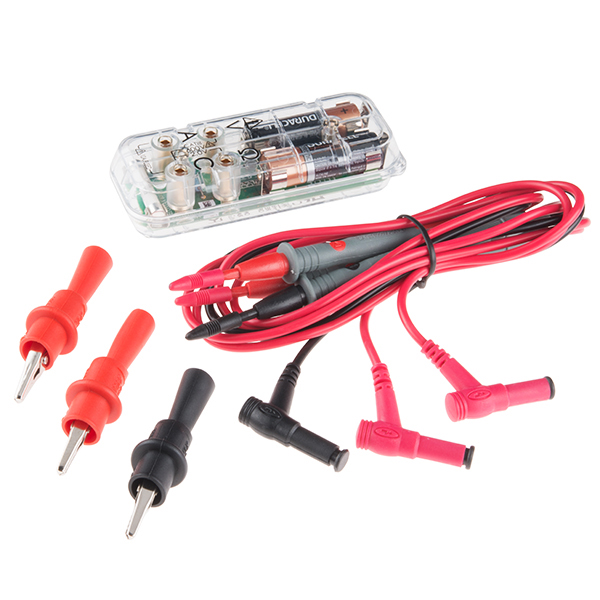
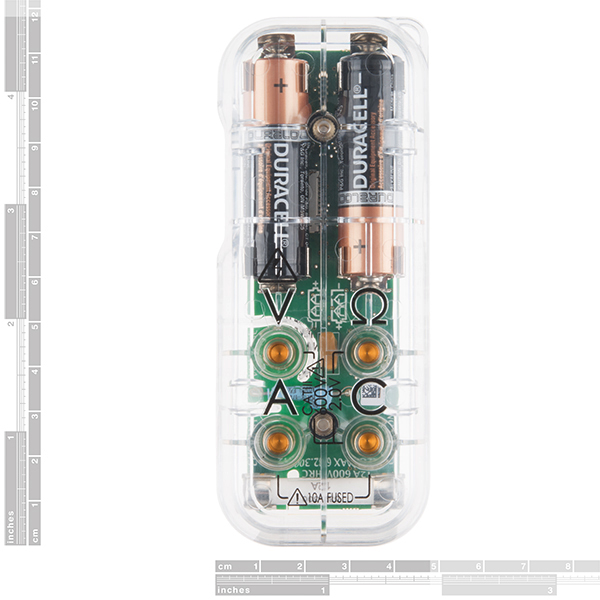

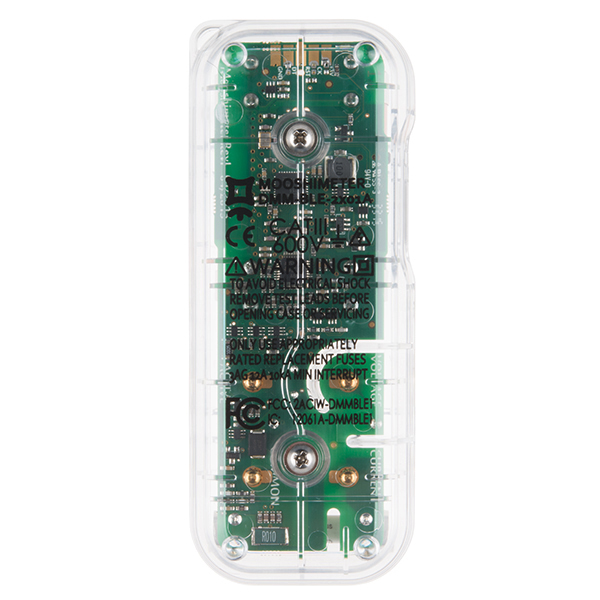
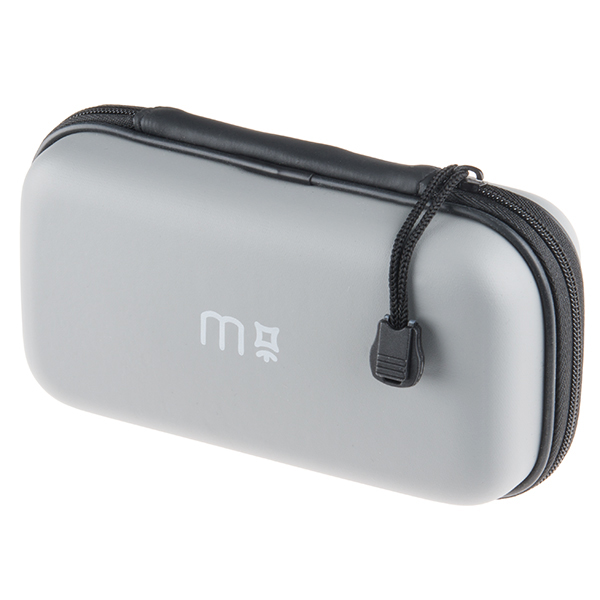

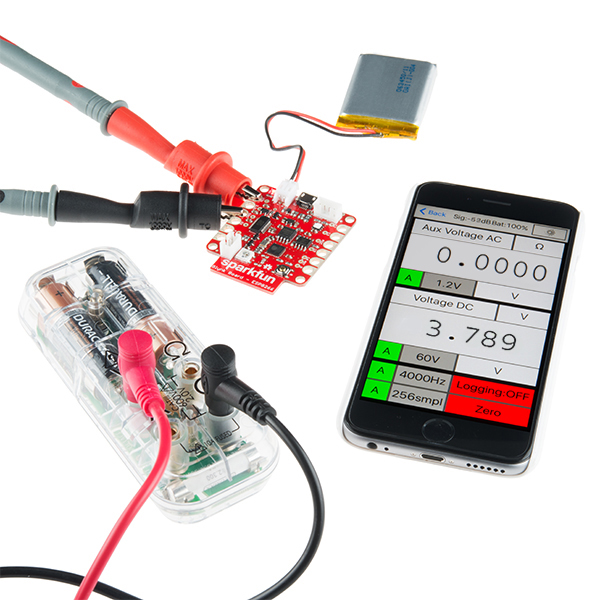
I backed this item in its crowdfunding campaign a couple of years ago and have used it almost daily since. It's extremely well-made, reliable, and useful.
I bought two of these through the original crowdfunding campaign; they work great for bench setups and day-long battery tests. You should definitely buy one of these instead of a Fluke.
Full disclosure: the inventor was a classmate
I have one of these and they are great. I carry at least two meters everywhere I travel. the moosh is the only one I have found that tsa does not have problem with. If you work at night having the ability to use your phone with its always on back light is great.
I would also like to post the link to the moosh blog where they discuss the case testing. It is rated to 600 volts and has been tested and certified. I use this on live 480 volts so this was important to me.
https://moosh.im/2014/07/dielectriclessonslearned/
I looked in Mooshimeter's forums and here, but didn't see any clear info on recommended devices for measuring temperature external to the built in temp measurement. Does Sparkfun have any recommended temp attachments?
I know on most multimeters, the temperature probe is usually a K-type thermocouple, similar to this. However, I am not aware of what the Mooshimeter is designed for; you may want to contact Mooshim (the manufacturer) for support. This forum post seems to indicate that the sensors are internal.
I have designed test and measurement equipment for over 40 years, so these comments are not from a novice, and I have been using my meter for about three weeks, so these aren't out-of-the-box knee-jerk reactions. For the most part, I truly like this meter! It is not as accurate as my 7 1/2 digit DMM, but it didn't cost $7k either. It is small and convenient, and accurate enough for day-to-day troubleshooting. I like having the tablet display, I don't have to probe tiny components and then rotate my head 60° to see the dmm (and then have my probe slip). The display is right next to the thing I am probing.
Of course there are things I'd change, that's true of just about everything, but for, what looks like a one-man startup, this is a real victory, I congratulate the designer.
I got one of these in the crowdfunding campaign, but didn't use it for a long time, mostly due to not doing much electronic stuff lately, but last week I used it to do some power monitoring of a goto telescope for battery sizing, and it really kicks butt. The app works well, (get a 32GB microSD for the logging, they're cheap now, so why not max out) and it impressed me at every turn that it worked well. Dual channel measurement and remote monitoring is surprisingly useful.
Robotics folks, seriously, no brainer.
I think this is really cool, and I may buy one. Especially if/when the price comes down a bit.
Two things I'd point out to the designers:
"Two channels" caught my eye - especially for a particular need of mine - closer examination reveals that, alas, it appears that only one can be voltage? One can be current, at a time, etc? Correct?
Diode check only to 1.0V? That seems low. I use my multimeter to check/show me the polarity of LEDs. I really would miss that. But then again, I guess this wouldn't be replacing my $12.95 "every day" meter, or my "good" $59.95 meter.
Bought this and really like it. The auto-range and accuracy is pretty amazing compared to your run-of-the-mill multimeter. The graphing leaves a lot to be desired however, and definitely feels like a work-in-progress, although it should be mentioned that it is still being updated. Would love to see some customizing capability for amp clamp, for example. And more options for adjusting the range would be very useful. A trigger feature would be great also.
Great product and outstanding customer support. This is a great gift both for the aspiring and advanced roboticist, and for solar power applications.
Documents:
User Manuel :)
Interesting device. I will have to look in to this.
Specs are non sequitur, or a poor design implementation. Has a 24 bit ADC and 1% accuracy. So resolution is several orders of magnitude greater than accuracy? What is the purpose of a 24b instrument if there are less than 10 bits of usable measurement data? And 600V implies measurement category III or IV. The images do not look like it was properly built to safely measure stuff in these categories. All that said, the general idea is clever.
James is right about the usefulness of extra resolution beyond the absolute accuracy spec. If you look at the datasheet for almost any sensor, the resolution spec is better than the absolute accuracy spec. If you're measuring a 1V source, your absolute accuracy will only be 0.01 V, but you will be able to detect a change in the source voltage at the sub-millivolt level.
I've had a Mooshimeter for a couple of months now and it works great! I definitely recommend the product.
Hi, creator here -
It's tested to CATIII 600V, which means it's safe to use on line voltages in a building protected by a breaker. You can see the whole story of the testing process on the blog at moosh.im
You're right that the precision of this instrument is much higher than the listed accuracy. That doesn't mean that the extra bits are worthless or thrown away. It means you can see sub-millivolt changes on a signal up to 60V. I use this level of resolution to see things like the voltage sag in a battery when an indicator LED turns on.
Anyway, I hope this answers some of your questions, best ~James
I have one and absolutely love it. It's super convenient and awesome as far as features go.
Thank you :)
Yes, extra bits of resolution above accuracy are nice and useful - to a point. But not when it's a waste. And not when it clouds the fact that the accuracy could and should be better.
I spent a second on Amazon and found a $55 meter (granted no BT etc, so not a fair comparison, but bear with me). Four digit, 4,000 count display, 0.5% accuracy. Extech EX330. 2^12 display. ~2^8 accuracy. That implies an "oversampling" (resolution over accuracy) of ~2^4 or actually 20.
The Mooshimeter captures 2^24, with 1%=~2^7 accuracy. Which gives an oversampling of ~2^17 or actually 168000. This seems like wayyyyyy overkill. I mean extra resolution is nice. But when it exceeds precision by that many orders of magnitude, who are you kidding?
When I took chemistry in high school, whoa so many years ago, the teacher informed us early on that if our reports carried more significant digits through each step than the instrument provided, our answer would be marked wrong. With this instrument, you've got to remember to round everything you write down (all those really nice 24 bit numbers) to 1%.
My points are:
1 - There's no excuse for a $100 instrument not to have better than 1% accuracy. I mean come on 1% on frequency? Hello? What kind of crystal are you using? The internal RC? Spend an extra $0.5 and get a precision reference so the instrument can self calibrate, and get yourself a crystal. $0.5=10X accuracy? (100X on frequency).
2 - Quit wasting your time collecting 24 bits of data if soooo many of them are ghosts. I mean do we really believe we're seeing 2^24 with unshielded probes? Put the ADC in 16 bit mode, collect the data at a higher rate (then you can do some of the stuff others have suggested, like: improve graphing, add triggering etc.), increase the accuracy...
Electrical measurement categories are more about application environment than specific voltage levels. You could easily encounter a few thousand volts inside an old CRT TV set, which is a CAT II device.